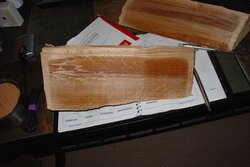So a lot of people have asked how you know when your wood is ready to burn. Well you can use moisture meters, you can weigh it, you can wait a year, etc. - there are many methods. So I have some oak that was split in November and I wanted to see how it is aging. So I took a split and split it again. You can see from the photo the amount that has dried out and the amount remaining to dry. Pretty cool.
Drying Red Oak - cool photo
- Thread starter cycloxer
- Start date
-
Active since 1995, Hearth.com is THE place on the internet for free information and advice about wood stoves, pellet stoves and other energy saving equipment.
We strive to provide opinions, articles, discussions and history related to Hearth Products and in a more general sense, energy issues.
We promote the EFFICIENT, RESPONSIBLE, CLEAN and SAFE use of all fuels, whether renewable or fossil.



